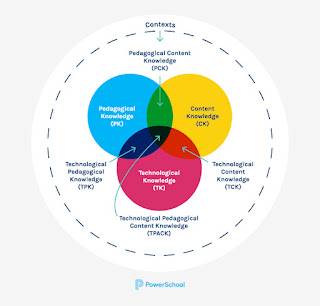ICT IN ELT
"Goal: how to use technologies to communicate, create, store, and manage information in English language teaching and learning."
I. 21st Century Education Framework
Framework
- Framework Definition
The framework is a template for developing applications based on desktops as well as websites.
- The Use of Framework
- to shorten the time of development
- to simplify the program
- to make the program more structured
- 21st Century Student Outcomes
- Key Subject and 21st Century Themes
- Learning and Innovation Skills
- Information, Media, and Technology Skills
- Life and Career Skills
- 21st Century Support Systems
- Standards and Assessments
- Curriculum and Instruction
- Professional Development
- Learning Environments
II. Digital Literacy Teacher Education
- Critical Thinking and Evaluation
- Collaboration
- Creativity
- Communication and Netiquette
- Finding and Selecting Information
- Digital Culture
- Online Safety Skills
- Functional Skill
* Why should we master digital literacy skills? We should master digital literacy skills to use the technology as best as possible and prevent all forms of crime and fraud.* How could we improve our digital competencies? We could improve it by thinking critically, sorting out the information from accurate references, understanding the digital culture, and using social media wisely.
III. Blended Teaching and Learning
* Simulations
IV. Technology Enhances Language Learning
- Approaches ICT in ELT
- CALL (Computer Assisted Language Learning)
Since the 1990s, CALL helps learners to study English, and teachers teach English by using computers.
- MALL (Mobile Assisted Language Learning)
As we know from the name, MALL is used by teachers to teach English and helped learners study English via mobile.
- RALL (Robot Assisted Language Learning)
In Taiwan, robots play the role of a teacher. They usually help the teacher in assessing and even become a substitute for dictionaries.
- TELL (Technology Enhanced Language Learning)
While TELL accommodates three of the previous terminology approaches, namely CALL, MALL, and RALL.
- Blended Learning
Blended learning is the combination of Face-to-Face and Online Learning.
- Flipped Learning
Different from Blended Learning, Flipped Learning is learning where students do autonomous learning before face-to-face classroom meetings. It aims to save time and give the students the opportunity to prepare themselves for ready receiving knowledge in the next class.
- LMS (Learning Management System)
LMS is an online learning platform. For instance: Google Classroom, Moodle, Quipper, Canva.Instructure, Edmodo, Schoology, etc. Different from Google Meet and Zoom Meeting, both are included in video conferences.
- TPACK (Technological Pedagogical Content Knowledge)
TPACK is a technology integration framework that identifies three types of knowledge instructors between technology and pedagogy in content development.
- SAMR (Substitute, Augment, Modify, Redefine)
Substitution: Technology acts as a direct tool substitute, with no functional change.
E.g.: Instead of a traditional whiteboard, the use of an interactive digital whiteboard can be made and save the outcome as a file.
Augmentation: Technology acts as a direct tool substitute, for functional improvement.
E.g.: Writing a paper using the inner features of Google Docs. Search functionality and spell check are among these features. Voice typing, exploration, etc.
Modification: Technology allows for significant task redesign
E.g.: Students create podcasts summing up a topic, which other students can use as a revision tool.
Redefinition: Technology allows the creation of new tasks, previously inconceivable.
E.g.: Recording students while they give a presentation or practice a physical skill, then using the recorded session to prompt student reflection can be very helpful.
- ICT Tools and Applications for ELT
* ICT Tools/Hardware
- Laptop
- Smartphones
- LCD Projector
- Interactive Whiteboard
- Digital Camera
- VR Glasses
- etc.
* ICT Applications/Software
- Internet
- Websites
- Electronic Resources
- Social Media
- LMS Program
- Educational Games
- etc.
- ICT Activities in ELT
* Teaching Presentation
* Resourcing Teaching Materials
* Assignments and Projects
* Classroom Activities
* Assessment
- ICT Integration in ELT
* Advantages:
- ICT provides more learning materials
- ICT increases student critical and creative thinking and also accommodates collaborative learning
- ICT promotes autonomous learning
- ICT improves students' and teachers' digital literacy skills
- ICT increases students' and teachers' positive attitudes to technology application
- ICT enhances students' motivation in learning
- ICT gives easiness and flexibility for long-distance learning
- ICT creates eco-friendly teaching and learning environment
* Disadvantages:
- Low teachers' knowledge and attitude toward ICT in ELT
- Unmotivated students in autonomous learning
- Insufficient policy and institutional
- Incomplete facility and technology support of ICT
- Health issues
- High cost and maintenance
Problems in ICT
- ICT Skills/Literacy: Presently, most teachers are still less competent in using ICT for teaching English. Even, they still don't have the interest to utilize technology maximally. It can impact the learning process. So, there are some solutions for us as future teachers to avoid this problem such as joining the training actively about ICT in ELT.
- Time Management and Allocation: It becomes a problem because teachers have to prepare all of the materials in hours even in several days, but it turns out that teachers just have little time exactly 40 minutes to convey the materials. (Online class)
- Internet Access/Technology Tools: Connection issues happen sometimes because of some troubles from the provider or due to a large number of users who use public Wi-Fi.
- Institutional Support and Policy: This had become a problem but since the pandemic era, institutions more supportive of using technology in the learning process.



Tidak ada komentar:
Posting Komentar